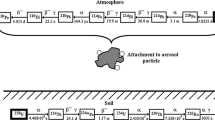During studies performed in 2010–2014, in the under-reactor rooms and deaerator stack of the sarcophagus at the Chernoby NPP, the average volume activity of radon was ~100 Bq/m3 and the average coefficient of equilibrium of radon and its daughter products was ~0.7. The maximum volume activity of radon reached 666 Bq/m3. The daughter products complicate radiation monitoring of the aerosol situation. In the inspected rooms of the under-reactor space and deaerator stack, the radiation exposure of workers due to inhalation of radon, thoron, and their daughter products can exceed 10% of the maximum admissible effective dose. It was determined that the carrier aerosols of the daughter products are submicron aerosols with active median aerodynamic diameter ~0.1 μm. The arch erected above the sarcophagus at the end of 2016 can degrade the radon radiation situation because of reduction of the natural ventilation.
Similar content being viewed by others
References
Yu. E. Zalmanzon and D. E. Fertman, “Evaluation of the possibility of automated monitoring of the contamination of the sarcophagus by radioactive aerosols,” in: Chernobyl-88: Reps. at the 1st All-Union Sci.-Techn. Cond. on the Results of Cleanup after the Accident at the Chernobyl NPP, Chernobyl (1989), Vol. 7, Pt. 1, pp. 61–65.
B. I. Ogorodnikov, E. M. Pazukhin, and A. A. Klyuchnikov, Radioactive Aerosols of the Sarcophagus: 1986-2006, Institute of the Safety of NPP, Chernobyl (2008).
V. A. Nikolaev, Solid-State Track Detectors in Radiation Research, Izd. Politekh. Universiteta, St. Petersburg (2012).
B. I. Ogorodnikov, V. E. Khan, E. M. Pazukhin, and V. A. Krasnov, “Radon and its daughter products in the sarcophagus in 2000–2010,” Probl. Bespeki At. Elektrost. i Chornobylya, Iss. 16, 130–136 (2016).
Seismic Radon Station SRS-05: Operating Manual, NTM-Zashchita Instrument Engineering Company, Moscow (2009).
A. A. Afonin, A. A. Kotlyarov, and A. Yu. Maksimov, “Methods and means based on chambers with electrodeposition for monitoring the volumetric activity of radon isotopes in various media,” ANRI, No. 2 (53), 82–86 (2008).
A. K. Budyka, B. I. Ogorodnikov, and V. I. Skitovich, “Filter pack technique for determination of aerosol particle sizes,” J. Aerosol Sci., 24, No. 1, S205–S206 (1993).
B. I. Ogorodnikov, V. E. Khan, and V. P. Koval’chuk, “Aerosols – witnesses to the destruction of lava-like fuel-containing materials in the sarcophagus,” Probl. Bespeki At. Elektrost. i Chornobylya, Iss. 20, 94–106 (2013).
B. I. Ogorodnikov, V. E. Khan, V. P. Kovalchuk, et al., “Composition and concentration of radioactive aerosols near the accumulation of lava-like fuel-containing materials in room 210/7 of the sarcophagus,” ibid., Iss. 24, 70–84 (2015).
V. I. Ogorodnikov, V. E. Khan, and V. P. Koval’chuk, “Characteristics of radioactive aerosols near the accumulation of lava-like fuel-containing materials in the premises 012/15 of the sarcophagus in 2014,” ibid., Iss. 25, pp. 125–138.
B. I. Ogorodnikov and V. E. Khan, “Radon in the sub-reactor room 012/7 of the sarcophagus,” ibid., Iss. 28, 82–91 (2017).
SanPin 2.6.1.2523-09, Radiation Safety Standards (NRB-99/2009), Federal Center for Hygiene and Epidemiology of Rospotrebnadzor, Moscow (2009).
E. M. Krisyuk, Radiation Background of Rooms, Energoatomizdat, Moscow (1989).
J. Postendörfer, “Properties and behaviour of radon and their decay products in air,” J. Aerosol Sci., 25, 219–263 (1994).
C. Papastefanou, Radioactive Aerosols, Elsevier (2008).
B. I. Ogorodnikov and V. E. Khan, “Volumetric activity of radon and its variability in the deaerator stack of the sarcophagus,” Probl. Bespeki At. Elektrost. i Chornobylya, Iss. 27, 80–88 (2016).
B. I. Ogorodnikov and V. E. Khan, “Radon and its daughter products in the deaerator stack of the sarcophagus at the Chernobyl NPP,” ANRI, No. 2 (89), 49– 58 (2017).
A. A. Tsapalov and S. I. Kuvshinnikov, “Dependence of volumetric activity of radon in rooms on the difference in indoor and outdoor air temperatures,” ibid., No. 2 (53), 37–43 (2008).
B. I. Ogorodnikov and V. E. Khan, “Radon in the sub-reactor room 012/7 of the sarcophagus,” Probl. Bespeki At. Elektrost. i Chornobylya, Iss. 28, 82–91 (2017).
Sources, Effects and Risks of Ionizing Radiation, United Nations Scientifi c Committee on the Effects of Atomic Radiation, Rep. of the General Assembly, United Nations, New York (2000).
R. E. Arutyunyan, L. A. Bolshov, A. A. Borovoi, et al., Nuclear Fuel in the Sarcophagus, Nauka, Moscow (2010).
NRBU-97/D-2000, Radiation Safety Standards of Ukraine, Kiev (2000).
Author information
Authors and Affiliations
Additional information
Translated from Atomnaya Énergiya, Vol. 125, No. 1, pp. 44–51. July, 2018.
Rights and permissions
About this article
Cite this article
Ogorodnikov, B.I., Khan, V.E. Radon and Its Effect on the Radiation Situation in the Chernobyl NPP Sarcophagus. At Energy 125, 45–54 (2018). https://doi.org/10.1007/s10512-018-0440-3
Received:
Published:
Issue Date:
DOI: https://doi.org/10.1007/s10512-018-0440-3




